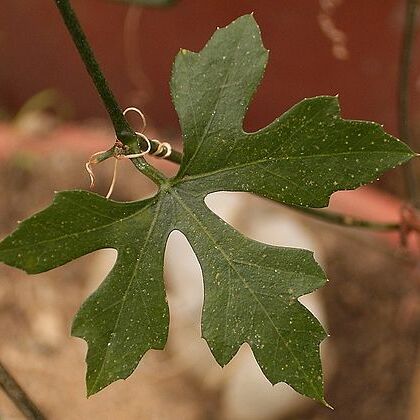Herbaceous or woody climbers, (sub)perennial, leafy stem 1-2 mm diam., glabrous or hairy, with or without rootstock or tubers; monoecious or dioecious (not in Asia?). Probract absent. Tendrils unbranched (elsewhere 2-branched). Leaves: petiole long; blade simple, subentire or (deeply) lobed. Flowers small; petals yellow (elsewhere whitish). Male inflorescences in short or long pedunculate racemes; pedicels short, persistent; bracts mostly absent. Male flowers: receptacle-tube cup-shaped; sepals small; petals free (elsewhere shortly united), imbricate, rounded at apex, glabrescent or short (glandular) hairy; stamens 3 (elsewhere 5 and all anthers 1-thecous), inserted in or close to the mouth of the receptacle-tube; filaments short, anthers two 2-thecous, one 1-thecous, with or without apically produced connective; thecae straight or little (much) curved, disc basal, minute, unlobed or not apparent and fused with the base of the receptacle-tube. Female flowers single or in a short, few-flowered raceme, sometimes co-axillary with male raceme; ovary ovoid, glabrous or hairy, 2-or 3-(or 4)-locular; ovules few; style distinct; stigmas 2 (or 3), each irregularly lobed; staminodes absent or usually 3 (or 5), inserted in the mouth of the tube; disc absent or not apparent. Fruit solitary or few-fascicled, ripening red, fleshy, glabrous or hairy, subglobose or ovoid, indehiscent (elsewhere fusiform, rarely dehiscent). Seeds 1 or 2 (elsewhere few), subglobose, usually smooth, not ornamented (elsewhere ornamented), without margin, edge entire.
Male flowers few to many in axillary racemes or fascicles, usually pedunculate. Receptacle-tube campanulate, lobes usually small. Corolla-lobes 5, united below. Stamens 5, all 1-thecous, in 2 pairs with one single, or 3, with the paired stamens ± united, 2 double 2-thecous, 1 single 1-thecous; filaments short, inserted in mouth of receptacle-tube; thecae short, straight or arcuate, lateral.
Female flowers axillary, solitary; ovary smooth, glabrous or variously pubescent; ovules few to many, horizontal; perianth as in male flowers; staminodes 3–5, small, inserted in mouth of tube; stigma 2-lobed.
Fruits solitary, small to medium-sized, succulent, cylindrical-fusiform to globose, often rostrate, red, indehiscent or dehiscent by a longitudinal slit.
Prostrate or scandent herbs with tuberous rootstock.
Seeds asymmetrically ovoid or subglobose, small.
Flowers small, yellowish, monoecious.
Tendrils simple or 2-fid.
Leaves simple, petiolate.

